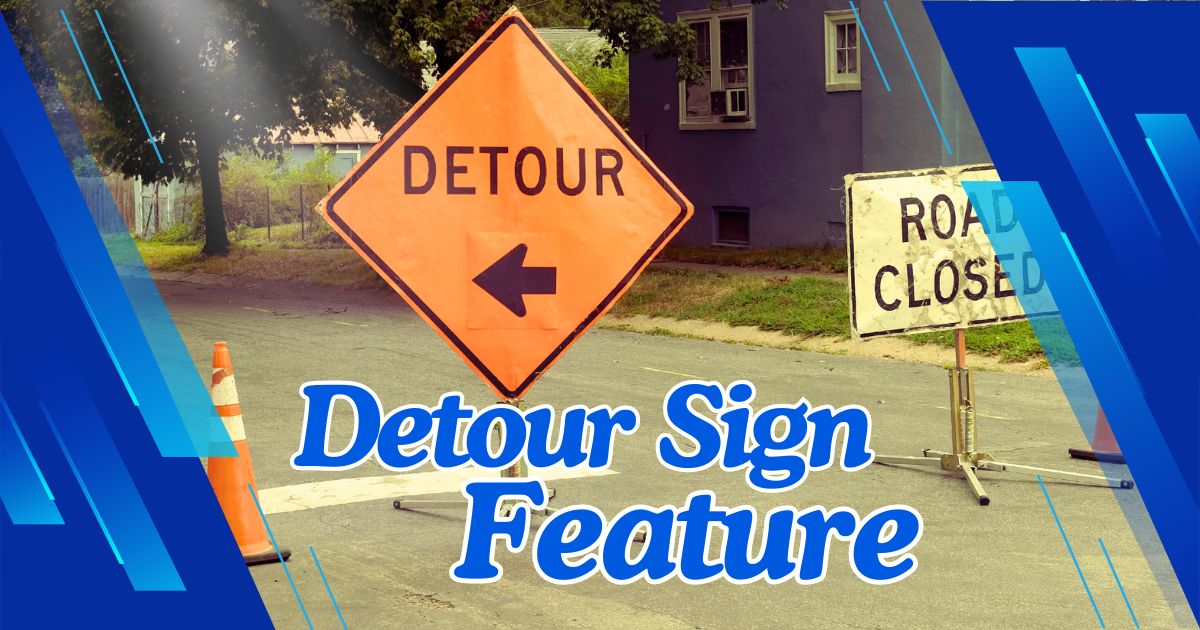Introduction: Understanding the Detour Sign Feature
Anyone who has driven through a construction zone or encountered a road closure knows how critical detour signs are in maintaining traffic safety and flow. These signs, often seen directing vehicles away from blocked routes, are more than just simple road markers—they are carefully designed tools that help drivers navigate unexpected changes on the road. Whether it’s for roadwork, emergencies, or temporary closures, detour signs play a vital role in ensuring both safety and efficiency.
In this article, we will explore the various features of detour signs, including their design, purpose, and how they work to keep traffic moving safely. By understanding the detour sign feature, you’ll gain insight into why these signs are so important and how they contribute to overall traffic management.
What Is a Detour Sign? The Basics Explained
A detour sign is a temporary road sign used to direct traffic away from its normal route, usually due to construction, maintenance, or road closures. These signs provide clear and immediate instructions to drivers, helping them find alternative routes and avoid congested or dangerous areas. Detour signs are typically brightly colored, often using orange, yellow, or fluorescent shades to ensure maximum visibility.
Purpose of Detour Signs
The primary function of a detour sign is to redirect traffic and provide clear, safe directions to drivers. Whether due to a temporary obstruction or planned construction, detour signs are essential for:
- Preventing accidents in areas under construction
- Maintaining traffic flow during road closures
- Providing alternative routes to avoid congestion
- Ensuring the safety of both drivers and construction workers
In any road environment, a properly placed detour sign is crucial in minimizing disruptions and ensuring that traffic moves smoothly despite the temporary obstacles.
Types of Detour Signs and Their Features
There are several different types of detour signs, each with its own unique features tailored to specific situations. Some are used for long-term roadwork, while others are deployed during emergencies or short-term closures. Understanding the different types of detour signs and their key features helps to appreciate their effectiveness.
1. Standard Detour Signs
Standard detour signs typically display a bold, black arrow on an orange background with the word “Detour” in large, clear text. These signs are placed at key intersections and decision points to guide drivers onto the correct alternate route.
2. Detour Route Signs
In some cases, particularly when the detour spans a large area, signs that display the words “Detour Route” may be used. These signs help direct drivers over longer distances, ensuring they stay on the intended alternate path without getting lost.
3. Electronic Detour Signs
Electronic message boards are often used in conjunction with traditional detour signs to provide real-time updates. These signs can alert drivers to upcoming detours well in advance, giving them time to plan their route.
4. Detour End Signs
Once the detour has successfully guided drivers around the obstacle, “End Detour” signs are placed to inform drivers that they can return to their original route. This helps reduce confusion and ensures a smooth transition back to normal traffic flow.
How Detour Signs Ensure Safety and Traffic Flow
Detour signs are designed with driver safety and efficient traffic flow in mind. In situations where road conditions have changed, clear and well-placed signage is crucial to avoid confusion and potential accidents. Here’s how detour signs help ensure road safety:
1. Clear Directional Guidance
Detour signs provide clear directional instructions, reducing the chances of driver confusion in areas with road closures or unfamiliar routes. The use of large arrows and simple text ensures that drivers can quickly understand where to go.
2. Increased Visibility
One of the key safety features of detour signs is their high visibility. Most detour signs are made with reflective materials or fluorescent colors to ensure they are easily seen, even in low-light conditions or during bad weather. This feature is crucial in helping drivers make quick and safe decisions.
3. Placement at Key Intersections
Detour signs are strategically placed at critical points along the road, such as intersections, roundabouts, or entry points to closed areas. This careful placement ensures that drivers receive directions well in advance, preventing sudden lane changes or last-minute decisions that could lead to accidents.
4. Coordination with Other Traffic Signs
Detour signs often work in conjunction with other temporary traffic signs, such as road closure notices, speed limit reductions, or work zone markers. Together, these signs create a comprehensive system that alerts drivers to potential hazards while ensuring a smooth detour experience.
Design and Visibility: Key Features of Effective Detour Signs
An effective detour sign must be designed to grab attention, provide clear instructions, and remain highly visible under a variety of conditions. Let’s explore some of the essential design features that make detour signs so effective in guiding traffic:
1. Bold, High-Contrast Colors
The use of bright orange or yellow backgrounds with black text and arrows ensures that detour signs stand out against the landscape. This color combination is recognized universally as a signal for caution or change, ensuring drivers remain alert when approaching these signs.
2. Reflective Materials
Many detour signs are made from retroreflective materials, which make them highly visible at night when illuminated by vehicle headlights. This feature is essential for nighttime construction zones or areas with poor lighting.
3. Large Text and Symbols
Detour signs typically use large, easy-to-read text and symbols to ensure that drivers can understand the message with just a quick glance. This is especially important in high-speed areas where drivers need to make decisions quickly.
4. Sturdy and Weatherproof
Detour signs are designed to withstand harsh weather conditions. Made from durable materials such as metal or high-strength plastic, these signs are resistant to wind, rain, and even direct sunlight, ensuring they remain visible and intact throughout the duration of the roadwork or closure.
Temporary vs Permanent Detour Signs: What’s the Difference?
While most detour signs are temporary, there are some situations where permanent detour signs may be used. Understanding the difference between temporary and permanent signs is crucial in determining the appropriate solution for various traffic management scenarios.
Temporary Detour Signs
Temporary detour signs are most commonly used during roadwork, construction projects, or emergencies. These signs are typically portable, allowing them to be set up and removed easily as needed. They are made from lightweight but durable materials and are often mounted on tripods or metal stands. Temporary detour signs are designed to be visible from long distances and are usually placed well before the affected area to give drivers ample warning.
Permanent Detour Signs
In some cases, particularly where a road closure or change is expected to last for a long period of time, permanent detour signs may be installed. These signs are more robust and are often mounted on fixed poles. They provide clear, long-term guidance to drivers and may be used in areas where a road is permanently closed or where a new traffic pattern has been established.
When to Use Each Type
- Temporary Detour Signs are used for short-term changes in traffic patterns, such as during construction, repairs, or accidents.
- Permanent Detour Signs are used in cases where the detour is expected to last for months or years, or when a road closure becomes permanent.
For more exciting blogs, visit our homepage Magzineco.
Conclusion: The Critical Role of Detour Signs in Traffic Safety
Detour signs are an essential part of road safety, particularly during times of construction, emergencies, or unexpected closures. By providing clear directions, ensuring high visibility, and working in conjunction with other traffic signs, detour signs help maintain the safety and flow of traffic in even the most challenging conditions.
From the careful selection of colors and reflective materials to their strategic placement, every aspect of a detour sign’s design is focused on one goal: keeping drivers and road workers safe while minimizing disruptions. Whether you encounter a temporary road closure or a long-term detour, these signs are an indispensable part of our daily travel, ensuring that we all reach our destinations safely.
FAQs About Detour Sign Features
- What is the primary purpose of a detour sign?
- The primary purpose of a detour sign is to redirect traffic safely and efficiently around road closures, construction zones, or other temporary obstacles.
- Are detour signs reflective for nighttime visibility?
- Yes, most detour signs are made from retroreflective materials to ensure high visibility during nighttime or in low-light conditions.
- What colors are typically used for detour signs?
- Detour signs are commonly designed with bright orange or yellow backgrounds and black text or symbols to ensure they stand out on the road.
- Can detour signs be permanent?
- While most detour signs are temporary, permanent detour signs may be used in cases where a road closure or detour is expected to last long-term.
- How do detour signs improve road safety?
- Detour signs provide clear guidance, improve visibility, and help prevent accidents by directing drivers safely around hazardous or closed-off areas.
- What are electronic detour signs used for?
- Electronic detour signs provide real-time updates and can be used to alert drivers to upcoming detours well in advance of the closure.
- How are detour signs placed to ensure maximum effectiveness?
- Detour signs are placed at key intersections and decision points, ensuring drivers receive the necessary information well before they encounter a closure or obstacle.
- What is the difference between temporary and permanent detour signs?
- Temporary detour signs are used for short-term closures and are portable, while permanent detour signs are installed for long-term or permanent changes to traffic patterns.
- Why are detour signs made with large text and symbols?
- Detour signs use large text and symbols to ensure drivers can quickly understand the message, especially in high-speed areas where rapid decision-making is required.
- What happens if detour signs are not used properly?
- Without proper detour signs, confusion, accidents, and traffic congestion can occur, leading to dangerous conditions for both drivers and road workers.




